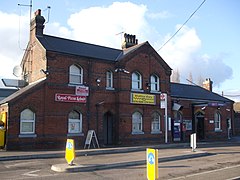
Cranham is a residential area of east London, and part of the London Borough of Havering. It is located 17.5 miles (28 km) east-northeast of Charing Cross and comprises an extensive built-up area to the north and a low density conservation area to the south surrounded by open land. It was historically a rural village in the county of Essex and formed an ancient parish. It is peripheral to London, forming the eastern edge of the urban sprawl. The economic history of Cranham is characterised by a shift from agriculture to housing development. As part of the suburban growth of London in the 20th century, Cranham significantly increased in population, becoming part of Hornchurch Urban District in 1934 and has formed part of Greater London since 1965. The 2011 Census population of Cranham was included in Upminster.

Upminster is a suburban town in East London, England, within the London Borough of Havering. Located 16.5 miles (26.6 km) east-northeast of Charing Cross, it is one of the locally important district centres identified in the London Plan.
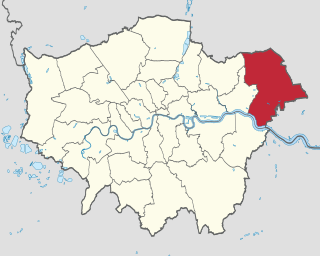
The London Borough of Havering in East London, England, forms part of Outer London. It has a population of 259,552 inhabitants; the principal town is Romford, while other communities are Hornchurch, Upminster, Collier Row and Rainham. The borough is mainly suburban, with large areas of protected open space. Romford is a major retail and night time entertainment centre, and to the south the borough extends into the London Riverside redevelopment area of the Thames Gateway. The name Havering is a reference to the Royal Liberty of Havering which occupied the area for several centuries. The local authority is Havering London Borough Council. It is the easternmost London borough.

Thurrock is a unitary authority area with borough status in the ceremonial county of Essex, England. It lies on the north bank of the River Thames immediately east of London and has over 18 miles (29 km) of riverfront including the Port of Tilbury, the principal port for London. Thurrock is within the London commuter belt and is an area of regeneration within the Thames Gateway redevelopment zone. The borough includes the northern ends of the Dartford Crossing.

Emerson Park is a suburban neighbourhood in the London Borough of Havering, east London. The neighbourhood developed as two large housing estates built on the 550 acres (2.2 km2) estate of Nelmes manor in the parish of Hornchurch. Emerson Park estate to the south started construction in 1895 and Great Nelmes estate to the north was begun in 1901. It is located north of the Romford–Upminster line and a station opened at Emerson Park in 1909. The mansion of Nelmes survived until it was demolished in 1967 to avoid preservation by the Civic Amenities Act and was replaced with a small housing estate called The Witherings. Emerson Park is located 15 miles (24.1 km) northeast of Charing Cross in Central London.

Tilbury is a port town in the borough of Thurrock, Essex, England. The present town was established as separate settlement in the late 19th century, on land that was mainly part of Chadwell St Mary. It contains a 16th century fort and an ancient cross-river ferry. Tilbury is part of the Port of London with a major deep-water port which contributes to the local economy. Situated 24 miles (38.5 km) east of central London and 23 miles (37 km) southwest of Southend-on-Sea, it is also the southernmost point in Essex.

Upminster is an interchange station serving the town of Upminster in the London Borough of Havering, Greater London. It is on the London, Tilbury and Southend line (LTSR), 15 miles 20 chains (24.5 km) down the line from London Fenchurch Street; it is the eastern terminus of the District line on the London Underground; and it is the eastern terminus of the Romford to Upminster Line on the London Overground network. Upminster is the easternmost station on the London Underground network as well as the easternmost National Rail station in London.

The London, Tilbury and Southend line, also known as Essex Thameside, is a commuter railway line on the British railway system. It connects Fenchurch Street station, in central London, with destinations in east London and Essex, including Barking, Upminster, Basildon, Grays, Tilbury, Southend and Shoeburyness.

Grays railway station is on the London, Tilbury and Southend line serving the town of Grays, Essex. It is 19 miles 70 chains (32.0 km) down the line from London Fenchurch Street via Rainham and is located at the junction where a branch line from Upminster via Ockendon re-joins the route from Rainham. Its three-letter station code is GRY.

Chafford Hundred railway station, also known as Chafford Hundred Lakeside station, is located on a single-track branch line of the London, Tilbury and Southend line, serving the area of Chafford Hundred as well as Lakeside Shopping Centre in Essex. It is 20 miles 77 chains (33.7 km) down the line from London Fenchurch Street via Upminster; it is situated between Ockendon and Grays. Its three-letter station code is CFH.
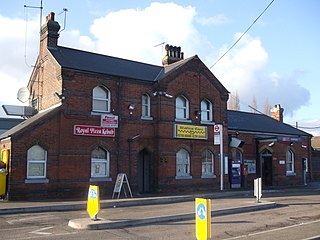
Ockendon railway station is located on a passing loop on a single-track branch of the London, Tilbury and Southend line, serving the town of South Ockendon, Essex. It is 18 miles 44 chains (29.9 km) down the line from London Fenchurch Street via Upminster; the following station on the branch is Chafford Hundred. Its three-letter station code is OCK.
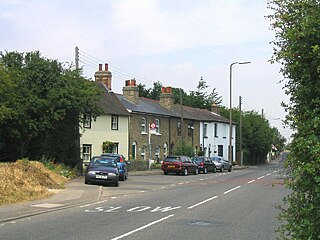
North Ockendon is the easternmost settlement of Greater London, England, and part of the London Borough of Havering. It is 18 miles (29 km) east-northeast of Central London and consists of a dispersed settlement within the Metropolitan Green Belt. It was historically an ancient parish in the county of Essex, which was abolished for civil purposes in 1936. North Ockendon is the only inhabited area in Greater London outside the M25 London Orbital Motorway. North Ockendon is north of South Ockendon, in Thurrock, Essex.
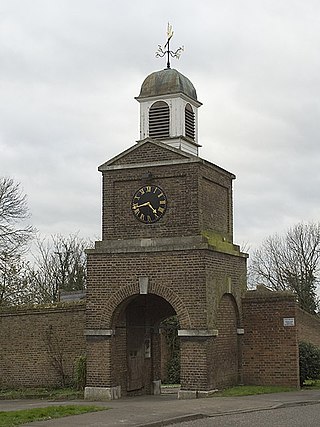
Purfleet-on-Thames is a town in the Thurrock unitary authority, Essex, England.

Aveley is a town and former civil parish in the unitary authority of Thurrock in Essex, England, and forms one of the traditional Church of England parishes. Aveley is 16 miles (26.2 km) east of Charing Cross. In the 2021 United Kingdom census it had a population of 9,801.

Southend Central railway station is on the London, Tilbury and Southend line and is one of two primary stations serving the city of Southend-on-Sea, Essex. The city's other main station is called Southend Victoria which is the terminus of a branch line off the Great Eastern Main Line. Southend Central is 35 miles 55 chains (57.43 km) down the line from London Fenchurch Street via Basildon and it is situated between Westcliff and Southend East stations. Its three-letter station code is SOC.

West Horndon railway station is on the London, Tilbury and Southend line, serving the village of West Horndon situated on the boundary of the boroughs of Brentwood and Thurrock, Essex. It is 19 miles 15 chains (30.9 km) down the main line from London Fenchurch Street and is situated between Upminster and Laindon. Its three-letter station code is WHR.

Pitsea railway station is on the London, Tilbury and Southend line, serving the small town of Pitsea in the borough of Basildon, Essex. It is situated at a junction where a loop via Grays re-joins the main line via Basildon. Down the main line it is 26 miles 42 chains (42.7 km) from London Fenchurch Street; via the loop it is 32 miles 37 chains (52.2 km) from Fenchurch Street. Its three-letter station code is PSE.

Leigh-on-Sea railway station is on the London, Tilbury and Southend line, serving the town of Leigh-on-Sea, Essex. It is 32 miles 43 chains (52.4 km) down the main line from London Fenchurch Street via Basildon and it is situated between Benfleet to the west and Chalkwell to the east. Its three-letter station code is LES.

East Tilbury is a village and former civil parish in the unitary authority of Thurrock borough, Essex, England, and one of the traditional Church of England parishes in Thurrock. In 2011 the ward had a population of 6,363.
Public transport in the London Borough of Havering, in east London, England, is a mix of National Rail, London Underground, London Overground and Elizabeth line and London Buses services. Rail services are primarily radial to central London with bus services providing most of the orbital connections. The public transport authority is Transport for London and the local authority is Havering London Borough Council.
